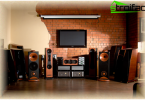How to choose a home theater
Audio and video equipment have long become integral attributes of home comfort. And if a couple of decades ago, a portable radio with a proud prefix “stereo” and a video player connected to the “Electron” TV seemed perfect, today we already want to enjoy high-quality music pouring from digital CDs at home and breathlessly dive into the plot saturated with special effects Oscar-winning blockbuster. Good technology is becoming more accessible and the problem of how to choose a home theater is solved by gray-haired music lovers of the 80s and advanced youth.
Content
- How to achieve a “presence effect”
- Projector specifications – making the right choice
- Choose a receiver – maximum supported format
- Acoustic characteristics and their properties
For most people, choosing a home theater really becomes a problem. After all, before lightening your budget by an impressive amount, I want to understand why the latest model’s TV from a well-known brand is not able to provide the same effect as a home theater? Do I need to pay attention to the rating of home theaters in the media and how do expensive models differ from budget ones? Finally, I want to understand which home theater is better to buy: pick up the system’s components on your own or immediately buy the “in one box” kit.
How to achieve a “presence effect”
Unlike the already mentioned TV of the latest model from a well-known brand, a home theater is a set of high-quality audio and video equipment, selected for a particular room and combined into a single complex. The highest quality sound of music and the “presence effect” in the plot of the film, for which home theaters are created, provide the following audio and video devices:
Columns – how to arrange?
They are placed around the perimeter of the room, connecting with a special cable. It is this technical solution that allows to achieve amazing reliability of sound effects and turn the illusion of action into “almost reality”.
AV receiver – what is it?
Usually included in a DVD player – the main device that combines all the selected equipment into a single complex. It distributes sounds and they are born and disappear in one or the other column, thereby creating that magical effect of “surround sound”, creating the viewer the feeling that the flickering thin face of the screen has dissolved and he has already become a participant in the events.
Home Theater Screen
Even planning what kind of home theater to choose and allocating a room for it in the house, they are usually determined with a screen option. This can be a TV with a diagonal of 29 inches, a plasma panel with a wide color palette for the home theater zone in the living room, or a projection television or a full-size projector screen for a separate home theater room. The main criterion is the richness and reliability of the color gamut, variety and color play that the modern film industry likes to surprise..
DVD player
A device that reads information from DVD discs and provides a movie, the sound of music in the highest quality modern format.
VCR – is it needed?
It does not belong to the obligatory attributes of a home theater, but retro lovers, having included it in the kit, can take out tapes of their favorite films from the VHS mezzanines and enjoy watching them in new high quality.
Projector specifications – making the right choice
What to consider when buying a projector in a home theater: rating, lamp power, contrast? Professionals assure that there are no worse or better video projectors, but only those that correspond to the purpose and budget of the buyer.
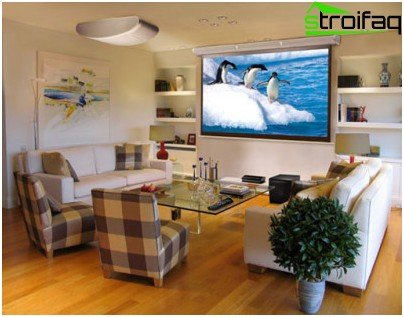
Choose a projector designed specifically for your home theater, not your office
Your choice of a home theater projector will be successful if:
- The projector is designed for home theater use only. Even at a very attractive price, do not buy an office projector: it is intended only for transferring a static image and is not able to reproduce the “picture” in dynamics.
- A good projector should have a sufficiently large ZOOM and lens shift: manual installation of video parameters under the ceiling, to put it mildly, is not convenient.
- The projector must have several HDMI inputs, or as many inputs of different formats as possible: the more they are, the wider the choice of compatible home theater equipment.
- When buying an LED projector (LED), choose a brightness of 500 lm or more that is optimal for covering a screen with a diagonal of 100 inches. True, the quality of color reproduction with such parameters is difficult to guarantee.
You can not pay attention to the passport parameters of contrast, lamp power, as well as technology (LCOS, DLP, 3LCD, etc.). All projectors designed for home theater systems are capable of providing good video quality. The projector brightness does not always depend on the power of the lamps, and for screens with a diagonal of up to 130 inches in general, this parameter can also be ignored.
Choose a receiver – maximum supported format
The AV receiver in the home theater system has several functions. The first and, possibly, the main one is the conversion of a digital audio signal into analog and its further transmission to the corresponding channels of the speaker system: center, rear, front and low-frequency subwoofer channels.
Today, all equipment for reproducing audio information meets the following standards: Dolby Digital and Dolby Sourround Prologgic, MPEG-2 Audio, DTS, as well as the latest audio standard THX Sourround EX.
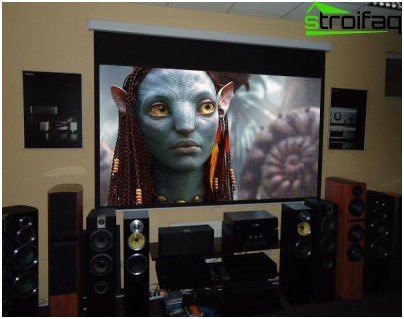
Make sure that your receiver supports the most popular audio standards: Dolby Digital and Dolby Sourround Prologgic, MPEG-2 Audio, DTS, as well as the latest audio standard THX Sourround EX
Therefore, the ideal choice of receiver for a home theater should support, if not all, then the maximum number of popular formats.
The second function of the receiver is to amplify the signal fed to the speakers of the speaker system. All receivers are equipped with at least five gain channels, but when choosing, you must correctly select the power of the device, taking into account the following conditions:
- the more power the receiver, the higher the quality of its work;
- the power of the front and rear channels should be the same;
- optimal receiver power for a room of 30 sq.m. – 100 watts per channel.
Acoustic characteristics and their properties
Despite the obvious significance of all elements of the home theater system, good acoustics remain his soul. It is the magic of quality sound that these systems owe their popularity to. And the question of how to choose the right home theater is one answer: create good acoustics.
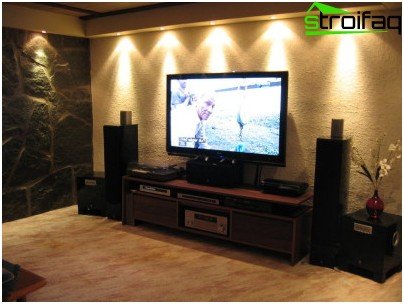
A perfect speaker system – the main condition for creating a good home theater
In the vast majority of home theaters, a 5.1 speaker system is used, in which the audio signal is transmitted to the following channels:
- frontal, left and right;
- rear, left and right;
- central;
- subwoofer, low frequency.
As a rule, any set of audio-video equipment of the “in one box” format includes an acoustic system and a DVD player with a receiver of “surround sound. In this case, the choice of acoustics for a home theater is to choose the sound power of the speakers and subwoofer of the low-frequency sound, as well as the material of the elements of the speaker system.
Power – fine-tuning options
Measured in watts. The lack of amplifier power negatively affects the dynamics of sound reproduction and its volume, but if the output power of the amplifier is higher than the acoustics power, the speakers may fail. The power parameters of the speaker system are selected based on the area of the home theater:
- up to 12 square meters m – 15-25 tons per channel;
- 12-20 sq.m – 25-50 W per each channel;
- 20-30 square meters – at least 50 watts per channel;
- from 30 sq.m – from 100 W per channel.
Sensitivity is the perfect “detail” of sound
Measured in decibels. Higher acoustics can provide higher sound at equal power. That is, the high sensitivity of the acoustics can to some extent compensate for the lack of power of the amplifier. The passport acoustic sensitivity indicator of 100 dB / W / m means that one speaker of a 1 W system creates a sound pressure of 100 dB at a distance of 1 m. The sensitivity of most public speaker systems ranges from 85 to 102 dB. High sensitivity provides good sound quality, but too powerful an amplifier can damage sensitive speakers.
Frequency Response Range
Measured in hertz. The indicator provides reliable reproduction of the audio signal. An acoustic system can be considered good if it can reproduce the entire sound range from 20 to 4000 Hz.
Speaker Body Material
Plastic and natural wood are the main materials from which home theaters are made: how to choose the best? Plastic is cheaper, but it is characterized by resonant sound that degrades the sound quality in general. Therefore, it is worth giving preference to wood, if not for all acoustics, then at least for the low-frequency unit.
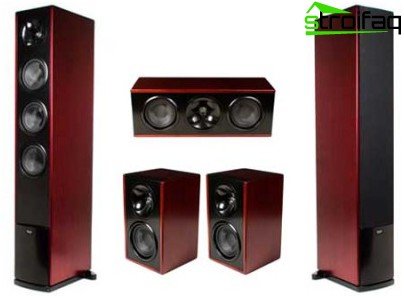
Acoustic system in a wooden case compared to a plastic one provides higher sound quality
We talked about what are the home theaters – how to choose the best, you decide. Undoubtedly, he will be the best, the one you have long dreamed of.


